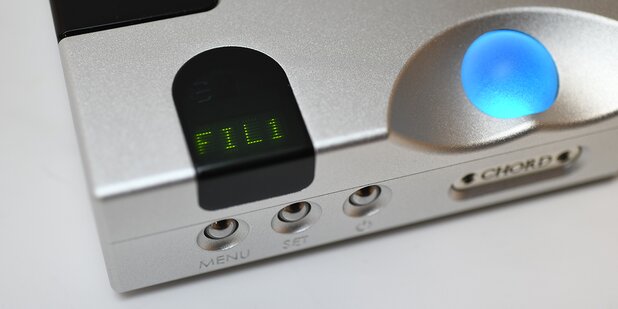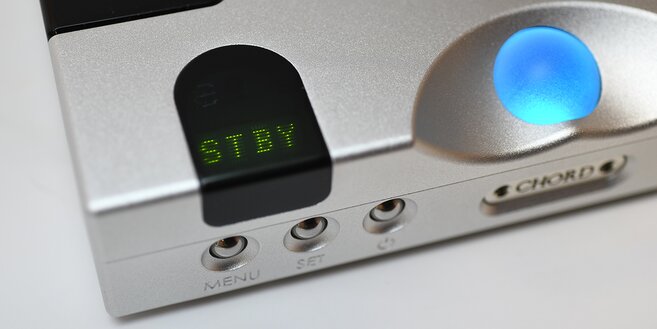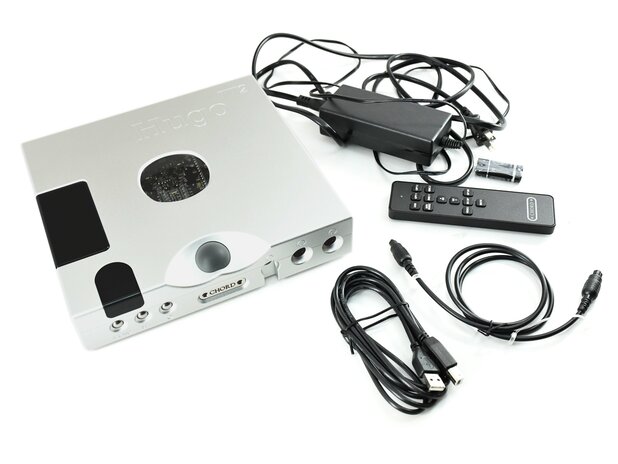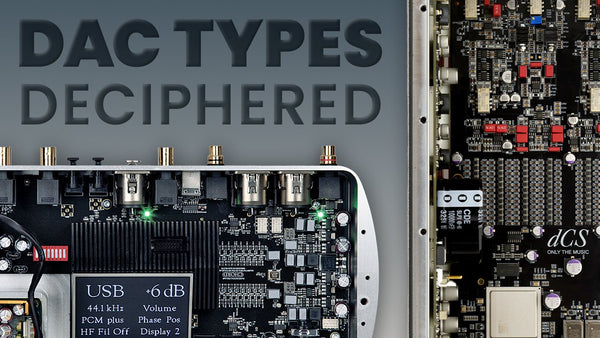Chord Hugo TT 2 DAC Review
Read Time: Approx. 20 min.

A New Generation of Tabletop DACs
Chord Electronics never ceases to amaze me. This Chord Hugo TT 2 Review explains and illustrates why Chord Electronics consistently ups its game with every new product it introduces to the HiFi marketplace. That is a tall feat to accomplish consistently.
Sure, every electronic company comes out with a new product from year to year, but in most cases, it is a small upgrade or lateral improvement just to say they have a new model. It usually takes several more years for most companies to produce a blockbuster, if ever. This reminds me of the movies. Rarely is the sequel to a movie or reboot as good as the original. Obviously, there are exceptions and Chord Electronics constantly makes exceptions to this rule!

PROS
- Detailed, Transparent, Natural Sound
- Combined Functionality of a DAC & Headphone Amp
CONS
- Not a portable solution
Hugo, Hugo TT, and 2Qute History
When the original Hugo, Hugo TT, and 2Qute were released, each one was not a huge jump in performance over the other in my opinion. What each did was meet certain ergonomic criteria. The Hugo was simply the pinnacle of portable audio. It really changed the playing field when it came to portable Amp and DAC combinations.
After the initial success of the original Hugo, Chord quickly saw a way to turn the Hugo into three products. First, they stripped the DAC section out of the Hugo and created the 2Qute. Chord realized that a small compact DAC is better suited for dedicated digital to analog conversion for your home or desktop system. No headphone amp was included, it was no longer powered by batteries. and it was simply a DAC. While the Hugo could be used as both a portable device, a dedicated DAC and a preamplifier for your home 2 channel audio system, the bottom line is it was not the best ergonomic fit for home audio use. There are USB and other digital connections on one side of the unit and analog outputs on the other so the unit had to be placed sideways in the rack and there was no remote. Ergonomically, it was challenging in this position for home audio and it was better suited on the desktop when used this way with a computer.
Original Hugo TT History
Next, the Hugo TT (Table Top) was introduced as a dedicated desktop or Table Top solution for your office or home system. It utilized once again the same DAC as in the Hugo, but Chord Electronics added some extra fun features.
- A bigger capacitor bank for peak demands while still utilizing a battery based power supply
- A much larger Bluetooth antenna range
- A remote control
- Balanced line level outputs to boot for your speaker amplifier
The percentage points in the difference of sound between each of these three were subtle to my ears. All -- the Hugo, 2Qute and Hugo TT -- utilized the same FPGA 26,368 tap length filter. The Hugo TT definitely had a little more oomph and was certainly quieter than the Hugo, but there wasn't a huge jump in performance. Each unit had their place in the audiophile and music lover's listening room and all were remarkable for their price point.
Design
Hugo TT 2: Inputs, Outputs, and Headphones
I found the warm-up up time very quick. There's no need to leave it on all the time if you don't want to and I would recommend using the standby function. The unit reaches its peak performance in about 10-15 minutes. For outputs, it has both RCA and XLR for connection to an external amplifier for speakers. As I noted earlier, it is a true balanced output from the XLRs. There are 2 x 1/4" and 1 x 1/8" inputs for headphone jacks. The 1/8" or 3.5mm input has a channel below it for a right-angled connection but unless you have the TT 2 hanging over the edge of the shelf, I would stick with a 1/8" or 3.5mm straight connector or otherwise you will put undue stress on the cable.
For headphones, you are looking at an output impedance of 45 milliohms which means super quiet output even on the most sensitive of IEMs or in-ear-monitors. The RCA and XLR have the same output impedances. In high gain, a maximum of 9.4v is at your disposal and at low gain a maximum 3.3v. What this means is that on hard to drive headphones you can drive them full performance and optimal sound quality. I don't know of a single headphone the Hugo TT 2 can't drive effortlessly. With some headphones, you will want to play around with whether you want to use low versus high gain and some may lay in the in-between area. It all comes down to load and sensitivity of the headphone so always try to use the low gain setting to prevent background hiss from too much power being thrown at your headphones. The Hugo TT 2 is also a true fully balanced design. The RCA provides a line level voltage of 2.5V but on the balanced XLR, you will have 2.5V on each phase so 5V in total. I wish there was a 4pin XLR on the front of the unit, but there's no reason why you can't utilize the rear XLR connection. The DX R and DX L output connections are for future connection possibilities and for now are not utilized.
The display will automatically turn off after a short pause in function use which will help minimize any potential noise displays that may be caused. Sometimes this can be annoying when playing with the filters for crossfeed and the digital shaping filter to test which might sound better to your ears. While trying to go back and forth between crossfeed functions if I wait too long it then shows the input function and then of course when I hit the SET button again I end up switching the input.
The solution? Use the remote for this so you won't run into the same problems I did -- plus, this solves the confusion. The Crossfeed really did not do much no matter what setting I tested. When you turn the gain up quite a bit, it becomes more apparent but, for the most part, I am not using it.
I've always personally found Crossfeed a better tool on cheaper audio gear and headphones. With the level of headphones you should be using with the Hugo TT 2, I think you to will find you won't use the crossfeed much. The volume control has numeric sequencing which for use in the studio will be very important. The Hugo TT 2 lacks a display and therefore color matching of the volume increases does not match to any DB gain chart. While I like the fun colors of the LEDs for different settings I have to admit, in the past, they did frustrate me. The important colors I always remembered but I always kept a chart from the manual taped to the wall as a reminder.

Wired Digital Inputs
The Hugo TT 2 comes with the following inputs:
- 1 x USB. Capable of PCM support: 44.1kHz, 48kHz, 88.2kHz, 96kHz, 176.4kHz, 192kHz, 358.8kHz, and 384kHz. DSD support: DSD 64 to DSD 512 – native via Windows
- 2 x Optical SPDIF connections. Each capable of receiving PCM signals of 44.1kHz, 48kHz, 88.2kHz, 96kHz, 176.4kHz, and 192kHz
- 2 x Coax BNC SPDIF connections. Each capable of receiving PCM signals of 44.1kHz, 48kHz, 88.2kHz, 96kHz, 176.4kHz, 192kHz, 358.8kHz, and 384kHz
When the 2 BNC connections are used in unison with the Hugo M Scaler these jump to: 44.1kHz, 48kHz, 88.2kHz, 96kHz, 176.4kHz, 192kHz, 358.8kHz, 384kHz, and 768kHz. We will go over this much more in the next review of the Hugo M Scaler. There are 2 Expansion BNC outputs labeled DX for future products and these are not active at this point. There are no analog inputs as this is a full digital masterpiece. And I do mean Masterpiece.
Sound
The Hugo TT 2 and Hugo 2 both include Digital Filters. While playing with the filter settings it really came down to which headphone I used. With the warmer headphones such as the Audeze LCD-3, I used green, a more neutral filter, and with the HiFiMan HE-1000, I used softer filters such as orange or red. The Focal Utopia was in the middle of these two so I used white most often.
Digital Filters- Explained
What does the digital filter do? The digital signal is shaped essentially and I would imagine if you did a frequency curve response you would see some small roll-offs at different frequencies to change the overall presentation of the digital music you are listening too. This is nothing dramatic but simply just a reworking of the energy of the response and changing subtly the dynamics of the sound. In order to reach the desired input, you have to push the menu button to scroll through the inputs. This made it a little hard to quickly compare the sound quality of different digital inputs as you had to scroll through the entire list to get to the input. You can't go back and forth quickly as it is a continuous one direction menu system. This is not a big deal for the average user, but for someone like me who is doing a lot of comparing, it was a little frustrating. I had the same issue with the filter and feedback settings. You can't go back and forth between the least effect and the most effect to test the result easily and you have to scroll through sequentially.
Bluetooth Sound
I used the Bluetooth option for the first time. I always shied away from this use as the bottom line it never sounds good to my ears no matter what electronic product I use. But for those interested, the Bluetooth circuit is the same as Hugo 2 DAC headphone amp and it is Bluetooth 2.1 with Apt-x. I don’t have data on all Digital Audio Players and what Bluetooth version they are on but Apple phones do not use Apt-x. Apple iPhones tend to sound worse using Bluetooth than other Android-based products such as Sony or Astell and Kern which have Apt-x technology. I tend to use Bluetooth more at social gatherings so I can let my guests connect to my audio system and enjoy their playlists. While the Bluetooth input does not come close to the sound quality of the other inputs, I can say that based on how good the rest of the audio circuit is in the Chord. It really did not sound as shrill as I would have thought and it is certainly a convenient medium for audio playback.
Features & Technology
Hugo TT 2: Tap Lengths Explained
I've reviewed the Hugo 2 and Qutest DAC previously, so the main focus on this review will be on the Hugo TT 2 with some notes on the Hugo M Scaler on what it does when attached. The release of the Hugo 2 and Qutest followed by the Hugo TT 2 and Hugo M Scaler introduced a big jump in FPGA filter tap lengths. Like the previous generation, the Hugo 2 and Qutest share the same DAC architecture and are rated at a tap length of 49,152 – 10 element Pulse Array design. However, when stepping up to the Hugo TT 2 the tap length gets bumped up to 98,304 or doubled.
The Chord Electronics flagship Dave is rated at a 164,000 tap length so the Hugo 2 TT is now halfway between the Hugo 2 and the Dave and is unlike the original line where they shared the same architecture. This means a much bigger jump in performance between the portable and the tabletop version. The price of the TT 2 is much more justified in my mind based on this one improvement alone, but there are a lot of other important improvements over the Hugo 2 as well. The Hugo TT 2 can be put into DAC mode. It this position the Headphone Amplifier is turned off and the output voltage stabilizes to a line level voltage a Preamp will prefer.
The Hugo TT 2 no longer utilizes a battery power supply. Instead, an external large 15V 4000mA power supply charges six super-capacitors capable of delivering huge reserves of linear dynamic currents when the music demands it. It has a peak output of 5A, 9.3V RMS which relates to producing serious power in the headphone amp section. At 300 ohms, it produces 1 watt and at 8 ohms it produces 18 watts.
Yes, you read that correctly. Believe it or not, you can now drive, in high gain mode, a pair of speakers from the XLR outputs (as long as they are sensitive and easy to drive).
Granted, I have to give a caveat that while Rob Watts says this is OK, I say "do it at your own risk." We will be producing custom XLR to speaker connections for this use, but really the Chord Electronics Etude Amplifier would be my recommendation when you want to use speakers.
Hugo TT 2: Linear Power Supply or Not?
Folks have been asking Moon Audio what external power linear power supply they should use as an upgrade. Chord is very clear on this point. Due to legal reasons they will neither condone nor recommend using third-party power supplies. Use of them will invalidate the warranty. They have had to take this hard stance now after several cases of damaged product due to the unregulated voltage output on some of these power supplies. Thus, Moon Audio won't be sourcing or recommending an option. While the Hugo TT 2 no longer uses batteries the Super Cap bank charges just like a battery.
You will notice when you first turn on the unit the display will say GHG. These are the capacitors getting their morning coffee or providing extra power at peak demands. The good thing about this design is the caps will last almost forever versus batteries. Rob Watts believes that a linear power supply unit (PSU) may actually provide a negative sound improvement. It will make it sound harder and brighter versus what the current PSU will do. The Hugo TT 2 PSU is not the external box that comes with it, it's the arrangement of filters and supercaps built into the TT 2. The supercap or large input inductor means the PSU brick only supplies a DC current. Moreover, the PSU brick has been very carefully selected for extremely low leakage currents into ground; replacing it with a battery produces no change at all in measured performance using a 96 kHz bandwidth. A linear PSU will add comparatively large levels of hum and RF noise, with orders of magnitude higher coupling capacitance to the mains.
Comparison: Chord Hugo TT 2 versus DAVE
I have lived with a Chord Dave on my desk at work for 5 days a week for about 10 hours a day for several years now. I use it mostly with near field monitors as I am on the phone a lot. However, when I am responding to emails and headphones are on my head, I know the Dave sound signature inside and out so it makes for an easy comparison to other products. The Headphone section of the Dave is the only weak point. Weak is a very over exaggeration and I don't mean this in a negative way as it is pretty darn good but the headphone amp is not at the same level as the DAC in the Dave. And the DAVE is my all time favorite DAC for sure, hands down. For 75% of the headphones, I use with the DAVE, I am quite satisfied. But on headphones that like power or are a bit harder to drive to peak performance, I feel I am wanting more. The DAVE has plenty of finesse and control but not when I want to Rock the House. I would imagine when the day comes for a Dave revision I foresee it having the Hugo TT 2 style of amplifier in it and then, the Dave would be a true End-Game piece of gear. I'll keep my fingers crossed this happens one day.
The headphone amp in the Hugo TT 2 is a beast. It controls and defines the pace of the headphone driver not like an Indy 500 Stock Car but more like a McLaren. Power, Control and Beauty are my three adjectives to describe its finesse.
Three of my favorite headphones are: Focal Utopia, HiFiMan HE1000 (V1 or V2), and Audeze LCD-3. The authority presented by the Dave, especially with the planar magnetic headphones is truly amazing and rare. The HE-1000 has the largest driver size when compared to the Utopia and LCD-3, resulting in a much lower frequency range. The LCD-3 has a huge bottom end or bass but it does not get as low and controlled as the HE-1000. Well, it was like listening to new headphones with the Hugo TT 2 attached to the Chord DAVE. It was a new experience and all of these headphones improved in ways I have not heard before.
The DAC in the Hugo TT 2 is no slouch when compared to the Dave which is definitely part of the reason for the re-acquaintance with my three favorite headphones. The TT 2 does not have the level of focus and precision of the Dave but in comparison to the Hugo TT (original) and even the Hugo 2, it is a big step up in performance and sound quality. Moreover, it has processing power that is halfway between the Hugo 2 and the Dave. What does this mean? It‘s like a supercharged computer.
Next, I connected the Hugo M Scaler and now we are talking. I'll get more into what the M Scaler does when I review it singularly but what I can say is that the Hugo TT 2 teamed up with the M Scaler gives the Dave a true run for the money. That is a Dave without an M Scaler, just to be clear as mud. Essentially, for less money than the Chord Dave, you get a lot more flexibility in what you can do and there is no limit to what headphone you can drive to peak performance. In my opinion, the Hugo TT 2 is a more exciting and vibrant sound and it is also warmer than the Dave. I equate this to the increased resolution in the Dave.
I would not say the Hugo TT 2 has the warmth of any tube-based product, but for a solid state design, it is on the warmer side. I also found it warmer than the Hugo 2 but with much more transparency. It reminds me of when the Chord Mojo first came out in 2015. See my Chord Mojo blog post here. I found it too to be warmer than the original Hugo and just using the Hugo TT 2 without the Hugo M Scaler I get a sense of realism in the sound. I have been trying to figure out the perfect analogy of what I am hearing.
Last night I attended a Neko Case concert at UNC. If you have not heard of her, I highly recommend giving her a listen. I would categorize her music as Americana or Folk. And she is an amazing songwriter; her lyrics are a blast! She has a unique high-pitched and smoky voice that is never glaring, fatiguing, or etching. The pitch and control of her voice is nothing short of amazing, and that is what I hear when I listen to the Hugo TT 2. Perfect pitch, the total control of its tonality is so engaging and perfect and the detail is precise and clean yet very smooth.
Lastly, I reviewed the TT2 with the TToby and speakers. The depth of the soundstage is deeper while using the TToby and speakers. Yet while headphone soundstage is shallower than a speaker, I could sense a bigger presence of the sound around my head instead of at my head or in my head. That's very impressive. The same upgrade can be heard when upgrading from the Qutest to the Hugo TT 2. Wow, just wow; and really no comparison to the original Hugo, HugoTT, 2Qute designs.
Dragon Audio Cables
[Black Dragon Coax Digital Cable]
There are a lot of reasons why you need to make sure your audio cables are not afterthoughts.
Our HiFi Audio Dragon Cables bring out more of what you love in your music and audio gear. If you love your headphones but wish they had a bit more top-end sparkle - a Silver Dragon Headphone Cable would be a great option. If your USB cables keep dying - as many stock cables do - then check out our quality USB Audio Cables. We say time and time again that materials matter, and our audio cables and custom geometries actually help to bring out those desired properties in your gear and music. We make tons of custom options for our customers so that you can get the right HiFi Audio cable for your exact needs. If you have any questions feel free to Contact Us and we'll be more than happy to help.
Verdict
Chord is really ahead of the curve in terms of performance for dollars spent on the Chord Hugo TT 2 DAC. You really have to pay a lot more money for competitive products from other manufacturers to compete with digital designs of Rob Watts. The man is a humble genius and one of the nicest men I've ever met. You can find him on the Head-Fi forums answering questions all day long about his designs and thoughts on digital media delivery. I have to say this product will win a product of the year award from me. Way to go, Chord Electronics. You've knocked it out of the park -- again. Bravo!
Featured Products
Related Videos
Chord Hugo TT 2 Unboxing
Chord Hugo TT 2 and M Scaler Review
How to Connect Chord Hugo to Apple Devices
What's in the Box
Specifications
Tap length filter: 93,304-tap 16FS WTA 1 – 10 element design
Connectivity (input): 1x USB Type-B, 2x DX (expansion inputs), 2x Coax BNC, 2x Optical & Bluetooth
Connectivity (output): Stereo XLR, Stereo RCA, 2x 6.5mm Headphone jack & 1x 3.5mm Headphone jack
PCM support: 44.1kHz, 48kHz, 88.2kHz, 96kHz, 176.4kHz, 192kHz, 358.8kHz, and 384kHz
DSD support: DSD 64 to DSD 512 – native via Windows
Volume control: Digital
Line-level mode: Activated via dual press of Input and Crossfeed upon startup
Driver support: Driverless with Mac OS X and Linux, driver required for Windows OS
Dynamic range: 127dB ‘A’ weighted
Noise: 4 uV ‘A’ weighted (high gain), 1.7 uV ‘A’ weighted (low gain) with no measurable noise floor modulation
Distortion: 0.00008% @ 2.5 V 300Ω; 0.00016% @ 6 W 8Ω
Output power (unbalanced): (@1% THD) 288 mW RMS 300Ω; 7.3 W RMS 8Ω
Output power (balanced): (@1% THD) 1.15 W RMS 300Ω; 18W RMS 8Ω
Output impedance: 0.042Ω
Stereo separation: 9 V RMS 300Ω -138dB
Dimensions: 130mm (L) x 100mm (W) x 21mm (H)
Boxed Dimensions: 220mm (L) x 122mm (W) x 85mm (H)








































